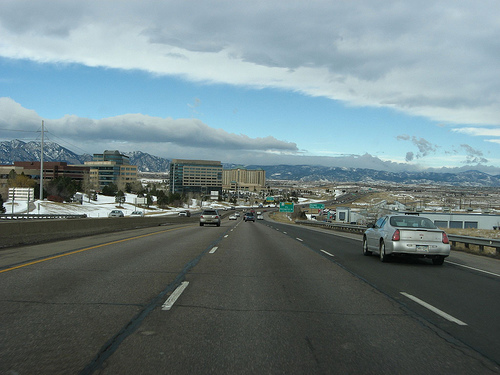The story of U.S. 36, a Colorado highway connecting Boulder with Denver, is similar to that of other roads throughout the country: it’s overworked and under-equipped. According to the New York Times, after opening in 1952, built to carry 3,000 cars daily by 1980, the highway was serving 14,000 cars daily by 1966. Today’s figures are vastly higher: the daily average is between 80,000 and 124,000 vehicles. And also as with many other highways, U.S. 36 is lined with fast food joints, shopping malls and other less-than-stellar scenery.

Following the lead of so many of America’s highways, the stretch of U.S. 36 between Boulder and Denver is distinctly unfriendly to any mode of transportation but the car. That’s set to change, though. From Ken Lund.
In a move that’s telling of the Federal Highway Administration’s evolving commitment to alternative transportation, U.S. 36 is getting a makeover. Many would say it’s about time: the highway, which is the most efficient way to get to Denver from Boulder, was ranked as Colorado’s worst “heartburn highway” by transportation research group TRIP because of its accidents, congestion and mediocre maintenance.
Today, work has commenced on developing a variety of thoroughly modern transit features on the highway: a bus rapid transit service, a fast lane for high-occupancy vehicles, an electronic toll system for single-occupant vehicles, and a bike path. Although these features have been spotted throughout the country, they haven’t yet been incorporated into one, individual project.
Commuters are especially pleased. Audrey DeBarros, the executive director of the commuter advocacy group 36 Commuting Solutions, which advocated for the U.S. 36 upgrades, called it “a 21st-century mobility project, not just traditional auto road capacity… People really do want to be able to bike, to be able to walk places, and not assume that driving in their car is the only way to travel every day.”
From roadtrafficsigns.com’s highway road signs department.
Other stakeholders agree. “This innovative approach is what we’re looking for in the future,” Victor M. Mendez, the head of the Federal Highway Administration, told the New York Times. “It’s an exciting project.”
It’s also a time- and cost-intensive project. It will take years to finish the work, and the costs are high. The $312 million first phase of the project is paid for by federal stimulus money, and state and private funds. The project’s second phase will be funded in part by private investors who in return receive a portion of toll revenue, until the year 2063. That mix of private-public funding has raised a few concerns; among them are consumer group U.S. PIRG’s. The Times reports that U.S. PIRG’s senior analyst for tax and budget policy, Phineas Baxandall says, “There are a lot of positive things about this project, but the private financing is essentially just a high-priced loan. Instead of raising more of their own public revenue to finance the road, the state will make larger annual payments to the private road builders.”
Colorado is gambling that the attractions of a truly multimodal highway will counterbalance the up-front costs of implementing change. From Ken Lund.
Aside from funding quandaries, positive expectations surrounding the project were bolstered earlier this week. The Daily Camera reported that travel along the U.S. 36 is improving: a recently released study (by, incidentally, the 36 Commuting group) reveals a lowered proportion of single drivers and a higher percentage of carpoolers and telecommuters last year over the year before.